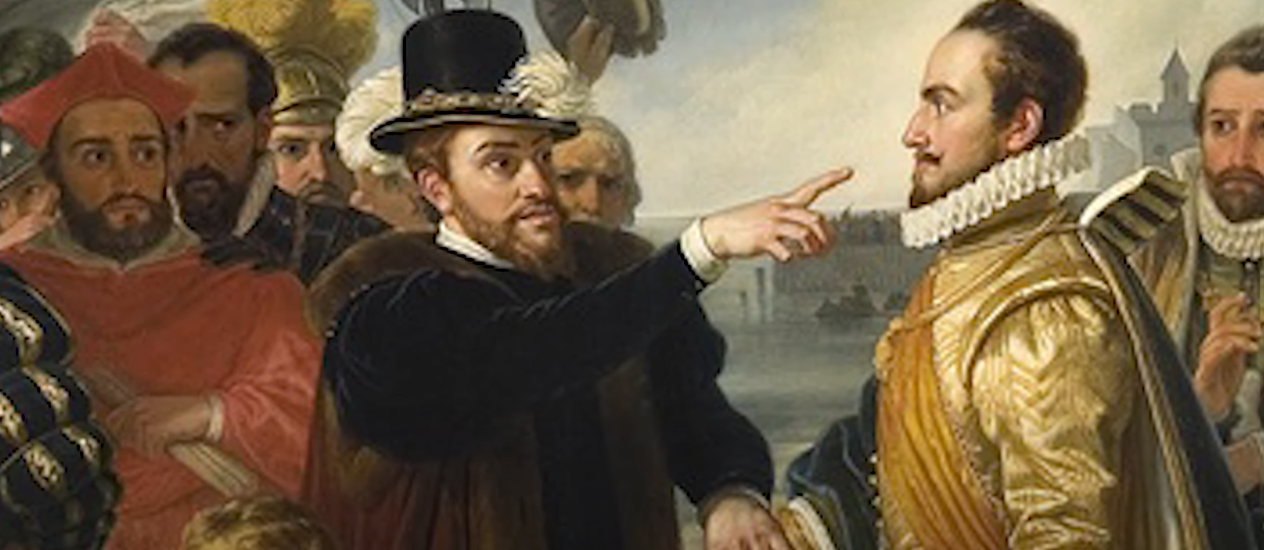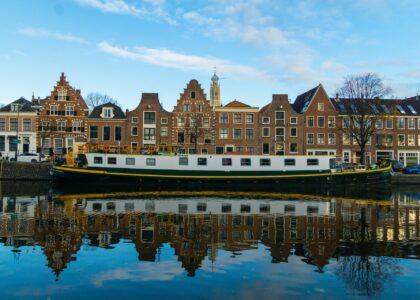The Dutch Golden Age, recognized as one of the most prosperous periods of Dutch history, spanned the 17th century. This time period is remarkable for a significant advancement in trade, science, military, and art. The following table encapsulates some of the key years within this period:
| Year | Event |
|---|---|
| 1602 | Establishment of the Dutch East India Company |
| 1609 | Twelve Years’ Truce starts |
| 1621 | Twelve Years’ Truce ends, and the Dutch West India Company is established |
| 1648 | Peace of Westphalia ends the Thirty Years’ War |
| 1672 | The year of disaster (“Rampjaar”) |
| 1674 | Treaty of Westminster ends the Third Anglo-Dutch War |
| 1702 | Death of William III, the last major stadtholder |
The Emergence of the Dutch Golden Age
Eighty Years’ War and the Birth of a Republic
The Dutch Golden Age found its roots in the end of the Eighty Years’ War, which culminated in the Treaty of Münster in 1648, an integral part of the Peace of Westphalia. The Treaty recognized the autonomy of the Dutch Republic, freeing it from Spanish rule.
The birth of the Dutch Republic offered an ideal setting for an economic takeoff:
- A unique form of governance was established: The republic was essentially a confederation of seven provinces, each with its own government, with overarching matters handled by the States General;
- Religious tolerance, particularly towards Protestants and Jews, provided a refuge for the persecuted, leading to an influx of capital, skills, and knowledge.
Trading Empires: The Dutch East India Company and West India Company
Perhaps the most potent symbols of Dutch ascendancy in the seventeenth century were the Dutch East India Company (VOC) and the Dutch West India Company (WIC).
The VOC, chartered in 1602, pioneered a host of innovations:
- It was the first multinational corporation, owned by shareholders who could transfer their shares to others;
- The VOC dominated the Spice Islands (modern Indonesia), securing valuable commodities like nutmeg, mace, cloves, and pepper.
| Company | Year Established | Key Commodities |
|---|---|---|
| VOC | 1602 | Spices |
| WIC | 1621 | Slaves, Sugar, Tobacco |
The WIC, founded in 1621, played a crucial role in the Atlantic trade system. The Company dealt in slaves, sugar, and tobacco, among other goods, and established the colony of New Netherland in North America, which included the settlement of New Amsterdam—today’s New York City.
The Height of the Dutch Golden Age
The Rise of Amsterdam
The Dutch Golden Age saw Amsterdam’s growth as Europe’s financial center. Key factors contributing to this development included:
- Banking & finance: The Amsterdam Exchange Bank, established in 1609, and the Amsterdam Stock Exchange, established in 1611, facilitated international trade and investments;
- Trade networks: Amsterdam’s merchants had trade connections spanning from the Baltic Sea to the Mediterranean, Africa, the Americas, and Asia;
- Infrastructure: A system of canals, warehouses, and shipyards facilitated the storage, transport, and trade of goods.
Cultural Flourishing
The Dutch Golden Age was also a time of incredible cultural and artistic achievement. The era is renowned for its:
- Painting: Artists such as Rembrandt, Vermeer, and Frans Hals created masterpieces that still captivate audiences today;
- Scientific advances: Groundbreaking discoveries were made in a variety of fields. For instance, Antonie van Leeuwenhoek advanced the development of the microscope, while Christiaan Huygens made significant contributions to physics and astronomy;
- Philosophy: Philosophers such as Baruch Spinoza and Hugo Grotius laid the groundwork for the Enlightenment and modern legal theory, respectively.
Naval Power
A significant feature of the Dutch Golden Age was its naval power. Factors that contributed to Dutch maritime dominance included:
- Shipbuilding innovation: The fluyt, a Dutch-designed ship, was cheaper to build and required fewer crew members to operate, leading to cost-effective trade and military operations;
- Sea battles: Naval victories, such as those against the British in the Anglo-Dutch Wars, underlined Dutch naval supremacy.
The Dutch Golden Age represented a unique intersection of military prowess, economic innovation, cultural achievement, and scientific discovery. Born out of the turmoil of a war for independence, this era saw the Dutch Republic become a global powerhouse in multiple spheres. Its legacy continues to influence our modern world in various ways, from art and culture to finance and commerce.
Cultural Flourishing and Scientific Advancements
During the Golden Age of the Dutch Republic, both cultural and scientific aspects experienced significant advancements and flourished. This period gave rise to numerous notable achievements, including remarkable contributions in art, science, philosophy, and architecture. Let’s explore each of these areas in more detail.
Art
The Golden Age of the Dutch Republic witnessed the emergence of some of the world’s most renowned artists. Notable figures such as Rembrandt van Rijn, Johannes Vermeer, and Frans Hals made lasting impacts on the art scene. These artists revolutionized the field by shifting the focus from traditional religious or mythological themes to depicting the everyday life of ordinary people. Their works showcased a distinctly Dutch style, characterized by attention to detail, mastery of light and shadow, and a rich color palette.
Some key artists of the Dutch Golden Age:
- Rembrandt van Rijn: Renowned for his mastery of light and shadow, Rembrandt created iconic portraits and historical paintings, such as “The Night Watch” and “The Anatomy Lesson of Dr. Nicolaes Tulp.”
- Johannes Vermeer: Vermeer’s works, such as “Girl with a Pearl Earring” and “The Milkmaid,” are celebrated for their exquisite use of light and subtle domestic scenes;
- Frans Hals: Known for his lively brushwork and ability to capture the essence of his subjects, Hals produced vibrant group portraits, including “The Banquet of the Officers of the St George Militia Company.”
Science
The Dutch Golden Age also witnessed remarkable scientific advancements. Pioneering scientists made groundbreaking discoveries across various fields, including astronomy, physics, and microbiology. Two prominent figures during this period were Christiaan Huygens and Antonie van Leeuwenhoek.
- Christiaan Huygens: Huygens, a mathematician, astronomer, and physicist, made significant contributions to the understanding of light, optics, and mechanics. He developed the wave theory of light and discovered Saturn’s moon Titan;
- Antonie van Leeuwenhoek: Often referred to as the “Father of Microbiology,” Leeuwenhoek’s pioneering work in microscopy allowed him to observe and document microorganisms, including bacteria and sperm cells, leading to groundbreaking discoveries in the field of microbiology.
Philosophy
The Golden Age of the Dutch Republic was marked by the emergence of influential philosophers, whose ideas on ethics, politics, and theology contributed to the Enlightenment. One notable philosopher of this era was Baruch Spinoza.
- Baruch Spinoza: Spinoza’s philosophical works, such as “Ethics” and “Theological-Political Treatise,” challenged prevailing religious and political beliefs. His ideas on rationalism, pantheism, and individual freedom had a profound impact on subsequent philosophical thought.
Architecture
Dutch architecture flourished during the Golden Age, with distinct features and iconic structures that reflected the wealth and aesthetic sensibilities of the period. Notable examples include the canal houses of Amsterdam.
- Canal Houses: These houses, found along the canals of Amsterdam, were characterized by their functional design and ornate façades. They served as residences for the wealthy and influential citizens, showcasing the prosperity of the Dutch Republic. The canal houses feature narrow, tall structures with elaborate gables and grand interiors.
The End of the Dutch Golden Age
The Rampjaar: A Year of Calamities
In 1672, a series of geopolitical and economic crises hit the Dutch Republic simultaneously, leading to a year commonly referred to as the ‘Rampjaar,’ or ‘Year of Disaster.’ This year marked a pivotal shift in the fortunes of the Dutch Republic:
- Military assault: England, France, and the German states of Münster and Cologne attacked the Dutch Republic. The Republic was plunged into a war on multiple fronts, severely straining its resources;
- Political instability: The delicate balance of power within the Republic faltered. Johan de Witt, the Grand Pensionary, and his brother were brutally murdered by a mob. The Orangists regained power with William III becoming the stadtholder;
- Economic downturn: The war disrupted the Dutch trade networks, leading to economic hardship. With war costs and loss of trade, the Republic’s financial stability was under threat.
The Death of William III and Political Decay
In 1702, William III, the last powerful stadtholder, died childless, plunging the Dutch Republic into a period of political uncertainty:
- The office of the stadtholder became a point of contention, leading to political instability;
- Infighting among provinces and the patrician class resulted in inefficiencies and corruption.
Economic Stagnation and Global Competition
Economic factors also played a significant role in the decline of the Dutch Golden Age:
- Declining industries: Some of the industries that had driven the Dutch economy, such as shipbuilding and herring fishing, started to decline due to overfishing and competition.
- Rising global competition: Emerging powers like England and France began to challenge Dutch dominance in global trade. The British Navigation Acts, which restricted foreign ships’ access to English colonies, particularly undermined Dutch trade.
- Cost of War: The series of wars drained the Dutch Republic’s resources.
| Economic Factors | Impact |
|---|---|
| Declining Industries | Led to reduced income and unemployment |
| Global Competition | Reduced Dutch trade and profits |
| Cost of War | Drained resources and hindered economic growth |
A Period of Slow Decline
The decline of the Dutch Golden Age was a slow process rather than a rapid collapse. Various elements of the Golden Age persisted even as the Dutch Republic’s global influence waned:
- Cultural achievements: Dutch art and science continued to flourish for some time, with the likes of Antonie van Leeuwenhoek and Christiaan Huygens continuing their scientific work into the 18th century;
- Financial services: Despite the economic downturn, Amsterdam retained its position as a leading financial center. The Amsterdam Exchange Bank and Amsterdam Stock Exchange continued to play a significant role in international finance;
- Colonial possessions: The Dutch colonial empire remained substantial, even as its influence declined. Areas such as the Dutch East Indies (modern Indonesia) continued to provide valuable trade goods.
The end of the Dutch Golden Age was characterized by a confluence of political, economic, and military pressures that gradually wore down the Republic’s dominance. Despite this, the Republic’s legacy continued, leaving a lasting impact on the world in areas ranging from art and culture to finance and global trade.
Conclusion
The Dutch Golden Age, spanning the 17th century, was a remarkable era of unparalleled prosperity and brilliance in Dutch history. It was characterized by significant advancements in trade, science, military, and art. The emergence of the Dutch Republic, marked by the Treaty of Münster in 1648, set the stage for economic takeoff, with unique governance and religious tolerance attracting capital and knowledge. The Dutch East India Company (VOC) and Dutch West India Company (WIC) symbolized Dutch ascendancy, dominating trade and establishing colonies. Amsterdam flourished as Europe’s financial center, driven by banking, trade networks, and infrastructure. The cultural flourishing during this period witnessed renowned artists like Rembrandt and Vermeer, while scientific pioneers like Huygens and Leeuwenhoek made groundbreaking discoveries. Dutch naval power and shipbuilding innovation cemented their dominance. However, the Dutch Golden Age gradually declined due to geopolitical and economic crises, political instability, rising global competition, and the cost of wars. Despite its end, the legacy of the Dutch Golden Age continues to influence various aspects of our modern world, leaving lasting impacts in art, science, finance, and global trade.
FAQ
The Dutch Golden Age was triggered by a combination of political independence, economic innovation, and naval power. The establishment of the Dutch Republic after the Eighty Years’ War provided a stable political structure, which, coupled with the global trade networks of the Dutch East India Company and Dutch West India Company, led to unprecedented economic prosperity.
Prominent figures from the Dutch Golden Age include artists like Rembrandt van Rijn and Johannes Vermeer, scientists like Christiaan Huygens and Antonie van Leeuwenhoek, and philosophers like Baruch Spinoza.
The end of the Dutch Golden Age can be attributed to various factors. The year 1672 was a significant blow, as the country was attacked by several European powers, which greatly impacted the Dutch economy. Political corruption, economic stagnation, and growing competition from other European countries also contributed to the end of the Golden Age.















